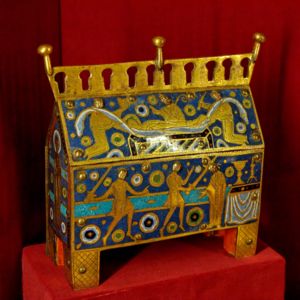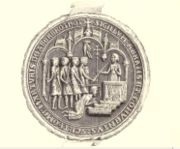Thomas Becket
2007 Schools Wikipedia Selection. Related subjects: Religious figures and leaders
| Thomas Becket of Canterbury | |
|---|---|
|
13th century manuscript illumination, an early depiction of Becket's assassination |
|
| 'Archbishop and Martyr' | |
| Born | c. 1118, London |
| Died | December 29, 1170, Canterbury |
| Venerated in | Roman Catholic Church, Anglican Communion |
| Beatified | February 21, 1173 |
| Major shrine | Canterbury Cathedral |
| Feast | December 29 |
| Attributes | Sword, Being murdered, dressed in chancellor's robe and neck chain |
| Patronage | Exeter College, Oxford; Portsmouth; Arbroath Abbey; secular clergy |
| Controversy | argumentative |
(St.) Thomas Becket (c 1118 – December 29, 1170) was Archbishop of Canterbury from 1162 to 1170. He is venerated as a saint and martyr by both the Roman Catholic Church and the Anglican Church. He engaged in a conflict with King Henry II over the rights and privileges of the Church and was assassinated by followers of the king in Canterbury Cathedral. He is also commonly known as Thomas à Becket, although this form may not have been contemporary.
Early life
Thomas Becket was born in circa 1118 at Cheapside, London, to Gilbert of Thierceville, Normandy, and Matilda (with a familiar name of Roheise or Rosea) of Caen. His parents were of the upper-middle class near Rouen.
One of Thomas's father's rich friends, Richer de L'Aigle, was attracted to the sisters of Thomas. He often invited Thomas to his estates in Sussex. There, Thomas learned to ride a horse, hunt, behave, and engage in popular sports such as jousting. Beginning when he was 10, Becket received an excellent education in civil and canon law at Merton Priory in England, and then overseas at Paris, Bologna, and Auxerre. Richer was later a signatory at the Constitutions of Clarendon against Thomas.
Upon returning to the Kingdom of England, he attracted the notice of Theobald, archbishop of Canterbury, who entrusted him with several important missions to Rome and finally made him archdeacon of Canterbury and provost of Beverley. He so distinguished himself by his zeal and efficiency that Theobald commended him to King Henry II when the important office of Lord Chancellor was vacant.
Henry, like all the Norman kings, desired to be absolute ruler of his dominions, both Church and State, and could find precedents in the traditions of the throne when he planned to do away with the special privileges of the English clergy, which he regarded as fetters on his authority. As Chancellor, Becket enforced the king’s danegeld taxes, a traditional medieval land tax that was exacted from all landowners, including churches and bishoprics. This created both a hardship and a resentment of Becket among the English Churchmen. To further implicate Becket as a secular man, he became an accomplished and extravagant courtier and a cheerful companion to the king's pleasures. Young Thomas was devoted to his master's interests with such a firm and yet diplomatic thoroughness that scarcely anyone, except perhaps John of Salisbury, doubted his allegiance to English royalty.
King Henry even sent his son Henry, later the "Young King", to live in Becket's household, it being the custom then for noble children to be fostered out to other noble houses. Later that would be one of the reasons his son would turn against him, having formed an emotional attachment to Becket as a foster-father. Henry the Young King was reported to have said Becket showed him more fatherly love in a day than his father did for his entire life.
Primacy
Thomas achieved his final position of power as the Archbishop of Canterbury in 1162, several months after the death of Theobald. King Henry intended to further his influence by directing the actions of Thomas, his loyal appointee, and diminish the independence and affluence of the Church in England. The infamous transformation of Becket into an ascetic occurred at this time. The hagiographers of the Saint portray his virtuous behaviour variously as (a) already part of his daily life (e.g. hair shirts worn under his courtier clothes) or (b) driven to devotion by Henry's lustful design or (c) motivated by self-interest and his own power grab. Most accounts of Thomas's early days as Archbishop are written after his death and are likely influenced by the political environment that existed then. The implications of Thomas's canonization for the Pope as well as the King translated to real political gain or loss for each
A rift grew between Henry and Thomas as the new Archbishop dropped his Chancellorship and consolidated the landed revenues of Canterbury under his control. So began a series of legal conflicts, such as the jurisdiction of secular courts over English clergy that accelerated antipathy between the two great offices. Attempts by King Henry to foment the opinion and influence of the other Bishoprics against Thomas began in Westminster in October 1163, where the King sought approval of stated royal privileges. This led to Clarendon where Thomas was officially asked to sign off on the King’s rights or face a complicated nuance of political repercussion.
The constitutions of Clarendon
King Henry II presided over the assembly at Clarendon Palace on January 30, 1164. He presented his demands in sixteen constitutions. What the King sought was less clerical independence and a weaker connection with Rome; he employed all his arts to induce their consent and was apparently successful with all but the Primate.
Finally even Becket expressed his willingness to agree to the constitutions, the Constitutions of Clarendon; but when it came to the actual signature, he defiantly refused. This meant war between the two powers. Henry endeavoured to rid himself of his antagonist by judicial process and summoned him to appear before a great council at Northampton on October 8, 1164, to answer allegations of contempt of royal authority and malfeasance in the Lord Chancellor's office.
Henry pursued the fugitive archbishop with a series of edicts, aimed at all his friends and supporters as well as Becket himself; but Louis VII of France received him with respect and offered him protection. He spent nearly two years in the Cistercian abbey of Pontigny, until Henry's threats against the order obliged him to move to Sens again.
Becket regarded himself as in full possession of all his prerogatives and desired to see his position enforced by the weapons of excommunication and interdict. But Pope Alexander III, though sympathizing with him in theory, favoured a milder and more diplomatic way of reaching his ends. Differences thus arose between pope and archbishop, which became even more bitter when legates were sent in 1167 with authority to act as arbitrators. Disregarding this limitation on his jurisdiction, and steadfast in his principles, Becket treated with the legates at great length, still conditioning his obedience to the king by the rights of his order.
His firmness seemed about to meet with its reward when at last ( 1170) the pope was on the point of fulfilling his threats and excommunicating the whole of Britain. At that point, Henry, alarmed by the prospect, held out hopes of an agreement that would allow Thomas to return to England and resume his place. However, both parties were holding to their former ground, and the desire for a reconciliation was only apparent.
Assassination
The tension between the two men would only be relieved by catastrophe. Passionate words from the angry king, reputedly either "Will no one rid me of this turbulent priest?", "Who will rid me of this meddlesome priest?", "Who will revenge me of the injuries I have sustained from one turbulent priest?", or even "What a band of loathsome vipers I have nursed in my bosom who will let their lord be insulted by this low-born cleric!", were interpreted as a royal command, and four knights— Reginald Fitzurse, Hugh de Moreville, William de Traci, and Richard Brito—set out to plot the murder of the archbishop. On Tuesday, December 29, 1170, they carried out their plan. Becket was murdered inside Canterbury Cathedral itself, in a spot near a door to the monastic cloister, the stairs into the crypt, and the stairs leading up into the quire of the cathedral, where the monks were chanting vespers. Several contemporary accounts of the murder exist; of particular note is that of Edward Grim, who was himself wounded in the attack.
Most historians agree that Henry didn't actually intend Becket to be murdered, despite his harsh words. Following his murder, it was discovered that Becket had worn a hairshirt under his archbishop's garments. Soon after, the faithful throughout Europe began venerating Becket as a martyr, and in 1173—barely three years after his death—he was canonized by Pope Alexander in Saint Peter's church in Segni. On July 12, 1174, in the midst of the Revolt of 1173–1174, Henry humbled himself with public penance at Becket's tomb (see also St. Dunstan's, Canterbury), which became one of the most popular pilgrimage sites in England until it was destroyed during the Dissolution of the Monasteries (1538 to 1541).
In 1220, Becket's remains were relocated from this first tomb to a shrine in the recently completed Trinity Chapel. The pavement where the shrine stood is today marked by a lighted candle. Modern day archbishops celebrate the Eucharist at this place to commemorate Becket's martyrdom and the translation of his body from his first burial place to the new shrine.



